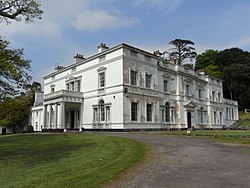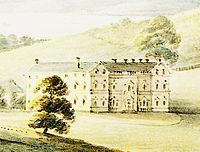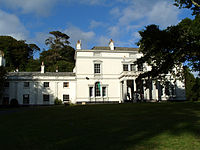Lupton House
| Lupton House | |
| Devon | |
|---|---|
 Lupton House | |
| Location | |
| Grid reference: | SX90265501 |
| Location: | 50°23’5"N, 3°32’42"W |
| Village: | Brixham |
| History | |
| For: | Charles Hayne |
| Country house | |
| Palladian | |
| Information | |
Lupton House is a Palladian country house in the Parish of Brixham, in south-eastern Devon. and the manor house of the historic manor of Lupton. The house was built by Charles II Hayne (1747-1821),[1] (Sheriff of Devon in 1772)[2] and Colonel of the North Devon Militia.
The house is today a Grade II* listed building.[3][4] The park and gardens, known as Lupton Park, are Grade II* listed in the National Register of Historic Parks and Gardens.[5]
History


The Hayne family had come to prominence in the person of John Hayne (d.1671), a merchant at Dartmouth during the reign of King Charles I, who had "acquired by inheritance and purchase various properties in Devon".[6] His great-great-grandson Charles II Hayne was only 22 when he inherited the Lupton estate in 1769.
Lupton House was built by Charles II Hayne (1747-1821), in the Palladium style much favoured in the Georgian period, as seen in many of the great country houses of that prosperous age. He never married, and lived alone, or as alohe as a gentleman with a household of servants can be at Lupton.
In 1788,[7] Hayne, though he had only lived in his new house for about twenty years, sold Lupton House to the judge Sir Francis Buller, 1st Baronet (1746-1800), of nearby Churston Court; Sir Francis then let to a tenant.[8] Sir Francis made Lupton his principal residence, though had another residence, on bleak Dartmoor, known as Prince Hall,[9] where he was a pioneer of moorland reclamation.[10] In about 1840 the house was remodelled in the neo-classical style by his grandson, Sir John Yarde-Buller, 3rd Baronet (1799–1871; created Baron Churston of Churston Ferrers and Lupton in 1858), to the designs of George Wightwick. In 1862 further alterations, since demolished, were made to the designs of Anthony Salvin,[1] who in 1826 had designed Mamhead House for the first baron's father-in-law, Sir Robert William Newman.[11]
It seems that two famous designers were involved in the laying out of Lupton Gardens in 1840, namely James Veitch and George Wightwick. The Italian gardens appear to have been at least partially designed by George Wightwick as a detailed coloured plan survives in his portfolio entitled: "Design for the Italian gardens, Lupton House, near Brixham: general plan and elevation and section of balustrade on its dwarf wall".[12]
The Gardeners Chronicle and Agricultural Gazette in 1869 reported:
The garden is bounded and likewise partially divided round the centre with a strong balustraded wall furnished with iron supports and chains drooping between the uprights. These chains prove capital training places for creepers and are well covered. The whole garden is carried out on a level with the base of the mansion. It is laid out on a solid basis of gravel and granite walks, the chief paths being edged with stone. The figure is very simple – a square cut into two by a centre walk which converges upon a fountain, the fountain itself being picked out upon the inner line of the semicircle that completes the boundary of the garden. The secondary arrangements as they may be termed or the dividing of these spaces into beds harmonise well with the general outline, architectural position and character of the garden.[13]
The feature also describes the kitchen garden:
The garden is divided into two portions – the fruit garden and the vegetable garden; good wide slips of ground are also carried all round outside the walls for cultural purposes and a nice young orchard of thriving trees occupies a space between the garden and a public road. The ground in the fruit garden has been made almost if not quite level that in th vegetable garden has a regular and even fall. Immense quantities of earth had to be moved to secure these forms of surface and it was turned to account thus:- At the boundary of the fruit garden a thick retaining wall was built; in front of this the back wall for a range of glass running right across the garden was built leaving room for fruit rooms, sheds stoke holes etc. between the two walls. All the spare earth was thus used to fill up the space between the two walls and to carry a terrace walk right across the garden, eight or ten feet above the vegetable ground.
Modern history
In 1926, much of the interior was destroyed by fire, and the house was rebuilt, but with the top floor omitted.[1] During thr Second World War, the house and grounds were used by American forces.
After the War the house became a hotel and then housed successively three schools, Fenton School, Lupton House School, and, between 1990 and 2004, Gramercy Hall School.[14]
In 1960 the property was acquired by Rowland Smith (d. 1979), proprietor of Rowland Smith Motors in Hampstead, North London, and of the Palace Hotel in Torquay, and who in 1949 had purchased as his country residence nearby Coleton Fishacre House.[15]
In 2008 the Lupton Trust was established which currently uses the house and grounds for a variety of commercial activities, mainly concerning community groups, charities and social enterprises, all designed to assist in financing a restoration.[16]
Outside links
| ("Wikimedia Commons" has material about Lupton House) |
- Lupton House - British Listed Buildings
- National Heritage List 1000696: Lupton House
References
- ↑ 1.0 1.1 1.2 Nikolaus Pevsner: The Buildings of England: Devon, 1952; 1989 Penguin Books ISBN 978-0-300-09596-8
- ↑ Risdon, Tristram 'Survey of Devon (1635)
- ↑ Gramercy Hall School, Lupton House - British Listed Buildings
- ↑ Lupton House profile, Parks & Gardens UK; accessed 21 April 2014.
- ↑ National Heritage List 1000696: Lupton Park
- ↑ Burke, 1871, p.605
- ↑ Journals of the Reverend John Swete (vol. 1) (published in Travels in Georgian Devon: The Illustrated Journals of Reverend John Swete, 1789-1800, ed. Todd Gray & Margery Rowe, 1999) , page 88 ISBN 978-0861149186
- ↑ Journals of the Reverend John Swete (published in Travels in Georgian Devon: The Illustrated Journals of Reverend John Swete, 1789-1800, ed. Todd Gray & Margery Rowe, 1999)
- ↑ Prince Hall
- ↑ Swete, vol 1, p. 91
- ↑ [1], bonhams.com; accessed 19 April 2014.
- ↑ See copy of plan atRoyal Institute of British Architects
- ↑ The Gardeners Chronicle and Agricultural Gazette, 13 March 1869, p.281[2]
- ↑ "The History of Lupton", discoverlupton.com; accessed 19 April 2014.
- ↑ [3], nationaltrust.org.uk; accessed 19 April 2014.
- ↑ "The Project", discoverlupton.com; accessed 19 April 2014.
